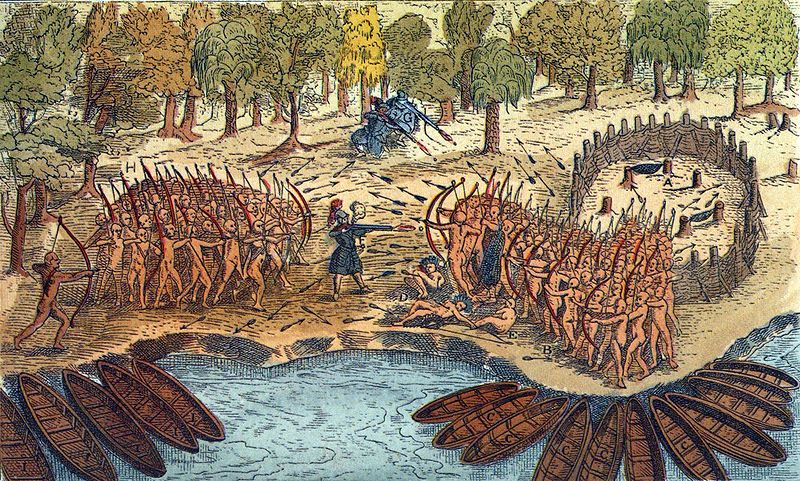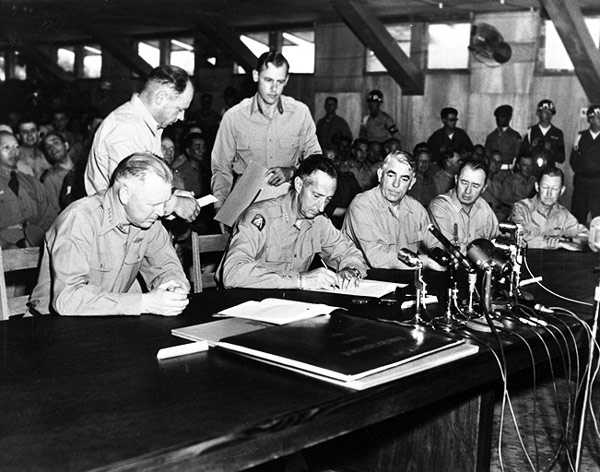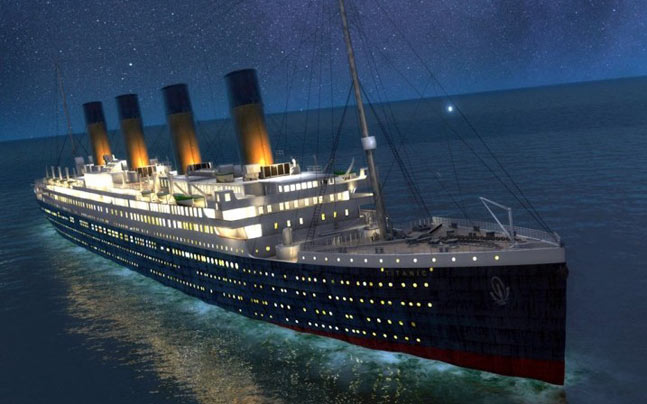July 30th to August 5th
* July 30th – 1609 – Samuel de Champlain joins skirmish against Iroquois – kills two chiefs with his arquebus.

The founder of Quebec City and one of the most charismatic figures in Canadian history, Samuel de Champlain opened up the St Lawrence river and extended French influence throughout the Great Lakes basin.
Samuel de Champlain was born in 1580 and by the time he passed way in 1635, he was known as the father of New France. He was a protestant which was unusual for a Frenchman of that age and grew up on the west coast of France in the seaport of Brouage. He became a sailor and learned the skills of navigation and cartography.
In 1608 Champlain sailed from Honfleur France in command of the Don-de-Dieu along with two other ships. The ships arrived at Tadoussac on the St Lawrence in June of 1608 and continued by small boat on to the site of Stadacona which was the Iroquois village that Jacques Cartier had made contact with. The village was abandoned, possibly due to inter-aboriginal warfare between the Iroquois and the Algonquin’s or the devastating effects of European diseases such as smallpox for which the Indians had no natural immunity.
On July 3rd, 1608 Champlain landed with his settlers and established a new settlement named Quebec City. They began work immediately and built several multistory buildings. During the first year, once the deep snows of Quebec had fallen, the dreaded disease of scurvy and smallpox also set in. 20 of the twenty-eight settlers who stayed for the winter died.
In 1609 Champlain made contact and formed friendly relations with the Huron, the Algonquin, the Montagnais and the Etchemin. The mighty Iroquois were their enemy and they appealed to Champlain to help them with their fight against them. Champlain and 9 of his soldiers set out with 300 Algonquin’s to explore the Iroquois lands to the south and travelled south along the Richelieu River to Lake Champlain.

Champlain and his party had not run into any Iroquois so 7 of the 9 soldiers and most of the Algonquin were allowed to return to Quebec City. Subsequently, they ran into an Iroquois war party of over 200 warriors. On July 30th the 200 Iroquois attacked Champlain, his 2 soldiers and his 30 Algonquin warriors near present-day Crown Point, NY. Champlain fired his arquebus at them and killed 2 of the Iroquois leaders with one shot. This was the first encounter that the Iroquois had experienced with gunpowder and they immediately scattered and fled. The battle lines between the French with the Algonquin’s and the English with the Iroquois was now set for the next 150 years.
* July 31st – 1965 J.K. Rowling born

On this day in 1965, Joanne Rowling, better known the world over as J.K. Rowling, the author and creator of the celebrated Harry Potter book series, is born near Bristol, England. Beginning in the late 1990s, Rowling’s seven Harry Potter novels became international blockbusters, selling over 400 million copies and being translated into more than 60 languages. The books also spawned a series of movies, video games and other merchandise that made Rowling one of the wealthiest people in the entertainment industry.
Rowling attended England’s University of Exeter, where she studied French, and later worked for human-rights organization Amnesty International in London and as a language instructor in Portugal. The idea for Harry Potter came to Rowling when she was riding a train from Manchester, England, to London in 1990. She began writing the first book that night. Rowling finished the book while living in Edinburgh, Scotland, where she struggled financially as a single mother and battled depression. Her completed manuscript was turned down by a number of publishers before she got a book deal with Bloomsbury Publishing in August 1996.
The first Harry Potter book debuted in Great Britain in 1997 under the title Harry Potter and the Philosopher’s Stone. The book was released in the United States the following year and renamed Harry Potter and the Sorcerer’s Stone. Children and adults alike were captivated by the story of the bespectacled boy wizard Harry, his friends Ron Weasley and Hermione Granger, their adventures at the Hogwarts School of Witchcraft and Wizardry and Harry’s struggles against his enemy, the evil Lord Voldemort.
On November 16, 2001, the first Harry Potter film, Harry Potter and the Sorcerer’s Stone, opened in America and was a huge box-office success. It was directed by Chris Columbus (Home Alone, Mrs. Doubtfire) and starred British child actor Daniel Radcliffe as Harry Potter, Rupert Grint as Ron and Emma Watson in the role of Hermione. A roster of celebrated actors took supporting roles in the film and its various sequels, including Ralph Fiennes, Maggie Smith, Alan Rickman, Emma Thompson, Richard Harris and Gary Oldman.

The seventh and final (according to Rowling’s predetermined plan) Harry Potter novel, Harry Potter and the Deathly Hallows, debuted in U.S. bookstores on July 21, 2007. Like all the previous Harry Potter books, it is slated to become a movie, to be released in 2010. To date, the Harry Potter films are the most financially successful series in history, having surpassed both the Star Wars and James Bond franchises.
* August 2nd – 1990 Iraq invades Kuwait

At about 2 a.m. local time, Iraqi forces invade Kuwait, Iraq’s tiny, oil-rich neighbor. Kuwait’s defense forces were rapidly overwhelmed, and those that were not destroyed retreated to Saudi Arabia. The emir of Kuwait, his family, and other government leaders fled to Saudi Arabia, and within hours Kuwait City had been captured and the Iraqis had established a provincial government. By annexing Kuwait, Iraq gained control of 20 percent of the world’s oil reserves and, for the first time, a substantial coastline on the Persian Gulf. The same day, the United Nations Security Council unanimously denounced the invasion and demanded Iraq’s immediate withdrawal from Kuwait. On August 6, the Security Council imposed a worldwide ban on trade with Iraq.
On August 9, Operation Desert Shield, the American defense of Saudi Arabia, began as U.S. forces raced to the Persian Gulf. Iraqi dictator Saddam Hussein, meanwhile, built up his occupying army in Kuwait to about 300,000 troops. On November 29, the U.N. Security Council passed a resolution authorizing the use of force against Iraq if it failed to withdraw by January 15, 1991. Hussein refused to withdraw his forces from Kuwait, which he had established as a province of Iraq, and some 700,000 allied troops, primarily American, gathered in the Middle East to enforce the deadline.
At 4:30 p.m. EST on January 16, 1991, Operation Desert Storm, the massive U.S.-led offensive against Iraq, began as the first fighter aircraft were launched from Saudi Arabia and off U.S. and British aircraft carriers in the Persian Gulf. All evening, aircraft from the U.S.-led military coalition pounded targets in and around Baghdad as the world watched the events transpire on television footage transmitted live via satellite from Iraq. Operation Desert Storm was conducted by an international coalition under the supreme command of U.S. General Norman Schwarzkopf and featured forces from 32 nations, including Britain, Egypt, France, Saudi Arabia, and Kuwait.
During the next six weeks, the allied force engaged in an intensive air war against Iraq’s military and civil infrastructure and encountered little effective resistance from the Iraqi air force or air defenses. Iraqi ground forces were helpless during this stage of the war, and Hussein’s only significant retaliatory measure was the launching of SCUD missile attacks against Israel and Saudi Arabia. Saddam hoped that the missile attacks would provoke Israel to enter the conflict, thus dissolving Arab support of the war. At the request of the United States, however, Israel remained out of the war.
On February 24, a massive coalition ground offensive began, and Iraq’s outdated and poorly supplied armed forces were rapidly overwhelmed. By the end of the day, the Iraqi army had effectively folded, 10,000 of its troops were held as prisoners, and a U.S. air base had been established deep inside Iraq. After less than four days, Kuwait was liberated, and the majority of Iraq’s armed forces had either surrendered, retreated to Iraq, or been destroyed.
On February 28, U.S. President George Bush declared a cease-fire, and on April 3 the U.N. Security Council passed Resolution 687, specifying conditions for a formal end to the conflict. According to the resolution, Bush’s cease-fire would become official, some sanctions would be lifted, but the ban on Iraqi oil sales would continue until Iraq destroyed its weapons of mass destruction under U.N. supervision. On April 6, Iraq accepted the resolution, and on April 11 the Security Council declared it in effect. During the next decade, Saddam Hussein frequently violated the terms of the peace agreement, prompting further allied air strikes and continuing U.N. sanctions.

In the Persian Gulf War, 148 American soldiers were killed and 457 wounded. The other allied nations suffered about 100 deaths combined during Operation Desert Storm. There are no official figures for the number of Iraqi casualties, but it is believed that at least 25,000 soldiers were killed and more than 75,000 were wounded, making it one of the most one-sided military conflicts in history. It is estimated that 100,000 Iraqi civilians died from wounds or from lack of adequate water, food, and medical supplies directly attributable to the Persian Gulf War. In the ensuing years, more than one million Iraqi civilians have died as a result of the subsequent U.N. sanctions.
* August 4th – 1944 Anne Frank captured

Acting on a tip from a Dutch informer, the Nazi Gestapo captures 15-year-old Jewish diarist Anne Frank and her family in a sealed-off area of an Amsterdam warehouse. The Franks had taken shelter there in 1942 out of fear of deportation to a Nazi concentration camp. They occupied the small space with another Jewish family and a single Jewish man and were aided by Christian friends, who brought them food and supplies. Anne spent much of her time in the “secret annex” working on her diary. The diary survived the war, overlooked by the Gestapo that discovered the hiding place, but Anne and nearly all of the others perished in the Nazi death camps.
Annelies Marie Frank was born in Frankfurt am Main, Germany, on June 12, 1929. She was the second daughter of Otto Frank and Edith Frank-Hollander, both of Jewish families that had lived in Germany for centuries. With the rise of Nazi leader Adolf Hitler in 1933, Otto moved his family to Amsterdam to escape the escalating Nazi persecution of Jews. In Holland, he ran a successful spice and jam business. Anne attended a Montessori school with other middle-class Dutch children, but with the German invasion of the Netherlands in 1940, she was forced to transfer to a Jewish school. In 1942, Otto began arranging a hiding place in an annex of his warehouse on the Prinsengracht Canal in Amsterdam.
On her 13th birthday in 1942, Anne began a diary relating her everyday experiences, her relationship with her family and friends, and observations about the increasingly dangerous world around her. Less than a month later, Anne’s older sister, Margot, received a call-up notice to report to a Nazi “work camp.” Fearing deportation to a Nazi concentration camp, the Frank family took shelter in the secret annex the next day. One week later, they were joined by Otto Frank’s business partner and his family. In November, a Jewish dentist—the eighth occupant of the hiding place—joined the group.
For two years, Anne kept a diary about her life in hiding that is marked with poignancy, humor, and insight. The entrance to the secret annex was hidden by a hinged bookcase, and former employees of Otto and other Dutch friends delivered them food and supplies procured at high risk. Anne and the others lived in rooms with blacked-out windows, and never flushed the toilet during the day out of fear that their presence would be detected. In June 1944, Anne’s spirits were raised by the Allied landing at Normandy, and she was hopeful that the long-awaited liberation of Holland would soon begin.

On August 1, 1944, Anne made her last entry in her diary. Three days later, 25 months of seclusion ended with the arrival of the Nazi Gestapo. Anne and the others had been given away by an unknown informer, and they were arrested along with two of the Christians who had helped shelter them. They were sent to a concentration camp in Holland, and in September Anne and most of the others were shipped to the Auschwitz death camp in Poland. In the fall of 1944, with the Soviet liberation of Poland underway, Anne was moved with her sister Margot to the Bergen-Belsen concentration camp in Germany. Suffering under the deplorable conditions of the camp, the two sisters caught typhus and died in early March 1945. The camp was liberated by the British less than two months later.
Otto Frank was the only one of the 10 to survive the Nazi death camps. After the war, he returned to Amsterdam via Russia, and was reunited with Miep Gies, one of his former employees who had helped shelter him. She handed him Anne’s diary, which she had found undisturbed after the Nazi raid. In 1947, Anne’s diary was published by Otto in its original Dutch as Diary of a Young Girl. An instant best-seller and eventually translated into more than 50 languages, The Diary of Anne Frank has served as a literary testament to the nearly six million Jews, including Anne herself, who were silenced in the Holocaust.
The Frank family’s hideaway at Prinsengracht 263 in Amsterdam opened as a museum in 1960. A new English translation of Anne’s diary in 1995 restored material that had been edited out of the original version, making the work nearly a third longer.
* August 5th – 1957 American Bandstand goes national

Television, rock and roll and teenagers. In the late 1950s, when television and rock and roll were new and when the biggest generation in American history was just about to enter its teens, it took a bit of originality to see the potential power in this now-obvious combination. The man who saw that potential more clearly than any other was a 26-year-old native of upstate New York named Dick Clark, who transformed himself and a local Philadelphia television program into two of the most culturally significant forces of the early rock-and-roll era. His iconic show, American Bandstand, began broadcasting nationally on this day in 1957, beaming images of clean-cut, average teenagers dancing to the not-so-clean-cut Jerry Lee Lewis’ “Whole Lotta Shakin’ Goin’ On” to 67 ABC affiliates across the nation.
The show that evolved into American Bandstand began on Philadephia’s WFIL-TV in 1952, a few years before the popular ascension of rock and roll. Hosted by local radio personality Bob Horn, the original Bandstand nevertheless established much of the basic format of its later incarnation. In the first year after Dick Clark took over as host in the summer of 1956, Bandstand remained a popular local hit, but it took Clark’s ambition to help it break out. When the ABC television network polled its affiliates in 1957 for suggestions to fill its 3:30 p.m. time slot, Clark pushed hard for Bandstand, which network executives picked up and scheduled for an August 5, 1957 premiere.
Renamed American Bandstand, the newly national program featured a number of new elements that became part of its trademark, including the high school gym-like bleachers and the famous segment in which teenage studio guests rated the newest records on a scale from 25 to 98 and offered such criticisms as “It’s got a good beat, and you can dance to it.” But the heart of American Bandstand always remained the sound of the day’s most popular music combined with the sight of the show’s unpolished teen “regulars” dancing and showing off the latest fashions in clothing and hairstyles.

American Bandstand aired five days a week in live national broadcast until 1963, when the show moved west to Los Angeles and began a 24-year run as a taped weekly program with Dick Clark as host.
This Week’s Sources:
* Canadian History Timeline – Canada’s Historical Chronology http://canadachannel.ca/todayincanadianhistory/index.php
* Canada History http://www.canadahistory.com/sections/eras/2worldsmeet/champlain/champlain.htm
* This Day In History – What Happened Today http://www.history.com/this-day-in-history/














